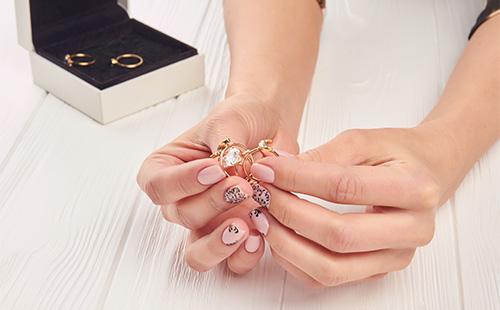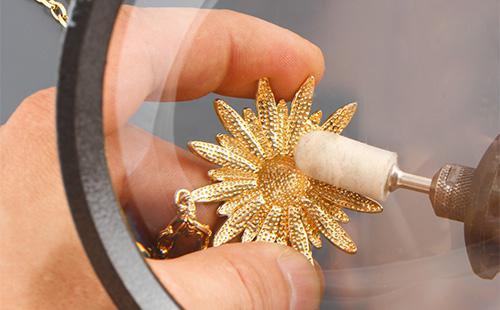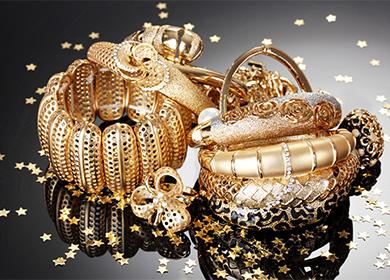The content of the article
A quality fake cannot be distinguished from the original. Therefore, the main advice is
Buy gold jewelry only in trusted stores with a good reputation. And in case of doubt - turn to professional jewelers to check the value and quality. Self-diagnosis of gold for authenticity, begin by examining the basic properties of yellow metal.
Properties and features of metal
The history of the noble metal can be compared with the history of civilization: the Old Testament contains lines about gold. In the jewelry business, metal has been used for over 5 thousand years: cult things, utensils were made from it, golden clothes. 100% pure gold does not exist - it cannot be absolutely cleaned of impurities of other metals (even bank bullion is 99.99% of gold, which is obtained exclusively in laboratory conditions). Gold stands out with three features.
- Strength. Aurum is a soft, ductile metal similar in hardness to nail hardness. Exclusively due to this property, the gold alloy can be given absolutely any shape, it can be easily processed. The new product is sold perfectly polished. Used jewelry is scratched and worn. If you scratch the gold with a pin, a trace will remain. After checking the metal “on the tooth”, a light impression will also remain.
- Smell. Real gold doesn't smell. If after friction in your hands a metal product has a characteristic smell, then this is hardly a real golden item.
- Colour. Pure gold is yellow in color with a warm shade and noble shine. The reddish tones are gold mixed with copper. The joints of the links will be slightly different in color: soldering is always brighter. True, this can be seen on the wicker elements of chains and bracelets. On earrings and rings, the color difference is invisible.
Kinds
To create gold jewelry, pure metal is not used because of its softness. In the original alloy, the percentage of precious metal is 37.3; 58.5 and 75%. This indicator determines the sample. The rest are impurities that are responsible for color and hardness. Currently, there are ten types of gold in different shades, which are obtained by alloying. This is the name of the process of joining alloys of other metals.
- Yellow. Classic look. The popular 585 sample contains 58.5% gold, 18% silver, the remainder is copper. A lesser known 750 sample is 75% gold, 17% silver, and the remainder is copper.
- White. It is obtained by combining gold with manganese, palladium or nickel. The latter metal is allergenic, therefore, in Europe, nickel in jewelry has been banned for more than 15 years.
- Pink. Trendy connection with copper and silver.
- Red. A lot of copper is present in the alloy (half). In European countries it is considered base.
- Green Exotic alloy of gold, silver and potassium.
- Blue. Compound with India.
- Blue. Compound with iron and chromium.
- Violet. Alloy with aluminum, which is used as an insert in jewelry.
- Brown. It is otherwise called chocolate and is created by special processing of the surface layer. Canadian jewelers call the new compound 584 breakdown.
- Black. Another trendy jewelry trend. This is either an oxidized alloy of gold, chromium and cobalt, or a special technology for coating a gold jewelry with a layer of amorphous carbon or black rhodium.
Authentication
Visual assessment is the fastest, easiest and, of course, the first way to independently verify the product for authenticity. Pay attention to two points.
- Try. Carefully study the "inside out" of the jewelry. With the naked eye, it is easy to distinguish between the stamp of the sample and the print of the manufacturer. They are mechanical and laser. A magnifier or a magnifying glass will help to consider the stigma. The print should have clear contours, numbers and markings should be readable and understandable. Fakes can also have a mark with a breakdown, and only a competent jeweler can distinguish a fake in this case. Decoration without sample - 100% fake.
- Tag. The passport of the decoration is a tag, whose presence is also mandatory. On it, the manufacturer puts the OTK stamp and indicates the following parameters: name, metal name, sample, size, weight, description of the inserts.

Magnet
High-grade gold will not stick to a powerful magnet, since it has anti-magnetic properties. Slightly attracted to aluminum and copper.
If the chain, earrings or ring adhere strongly to the magnet, this means that they contain an impurity that lends itself to the influence of the magnetic field. If the 585 gold (or higher) is strongly magnetized - the home test for authenticity is not passed. This is a fake, which includes iron, nickel, steel, cobalt or their alloys.
Iodine
Gold, being an inert metal, practically does not oxidize and enters into a chemical reaction with just a few substances. Iodine is one of them. It is considered a good marker for a noble metal. Exercise maximum accuracy and proceed in three steps.
- Application On the back side or inconspicuous part of the product, we apply a drop of iodine (you can use a toothpick).
- Expectation. We will wait one or two minutes. Remove iodine with a cotton pad.
- Evaluation of the result. If a chemical reaction has occurred and a stain remains, the script is in front of you. In general, jewelry is “afraid” of iodine: they darken, even if they just lie next to the bubble. Immediately remove the stain with toothpaste or toothpowder. The absence of traces of iodine or light milk stains are characteristic of a fake.
Lapis pencil
In home examination, you can use this antiseptic, silver-containing remedy, the main function of which is hemostatic. On a decoration moistened with water with a lapis pencil, you need to draw a line and after a few seconds to erase it. The remaining trace will indicate a fake.
Acid
The chemical properties of the metal are such that it does not interact with acids and alkalis. Therefore, the method is considered one of the reliable.To distinguish real jewelry from fake, use nitric acid. Proceed in two steps.
- Application Place the product in a clean metal dish. Using a pipette, apply a drop of nitric acid to the decoration.
- Score. If the gold changes color to greenish or stains, it is a crude fake. The color will change slightly, it will acquire a milky hue - on a gilt product or if there are impurities in the composition. The color and appearance of real gold will remain unchanged.
You can also use a special set with acid, sold in jewelry stores and in chemical stores, laboratory supplies.

Test for fashionable white products
The reason for the popularity of white gold is fashion and its features: it is much harder than yellow, which allows you to reliably fix and frame precious stones.
The alloy contains palladium, manganese or nickel, which stains it in a silver-matte color. In everyday life, white gold is mistakenly called platinum, which is actually much more expensive. In appearance, white metal is very similar to silver, so they can also be easily confused.
Sulfur ointment, which is sold in pharmacies, will help check white gold at home. Decoration needs to be smeared for a couple of hours with a thick layer of the drug. Silver or an alloy with a high content of it will necessarily blacken, and white gold will retain its original appearance, that is, a chemical reaction will not occur.
The time of special demand for jewelry is New Year's Eve (the main peak is the last week of the end of the year). According to statistics, from the first days of December, the number of fraudulent cases has at least doubled. In order not to run into a fake - be vigilant, pay attention to the presence of samples and tags. And most importantly - under no circumstances do not buy jewelry in the underpasses, on the beach, in markets from dubious sellers. Make jewelry purchases only in specialized stores. If you doubt the authenticity of the jewelry, contact the professionals who, using special equipment, will accurately determine the quality and price of the metal. It is clear that this service will be paid. But the acquisition of gold is a kind of investment.

